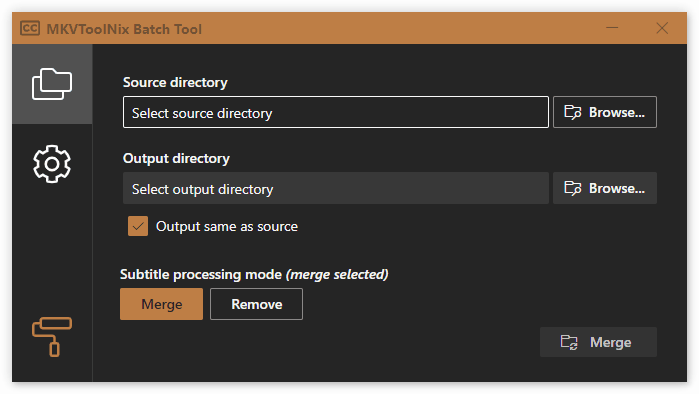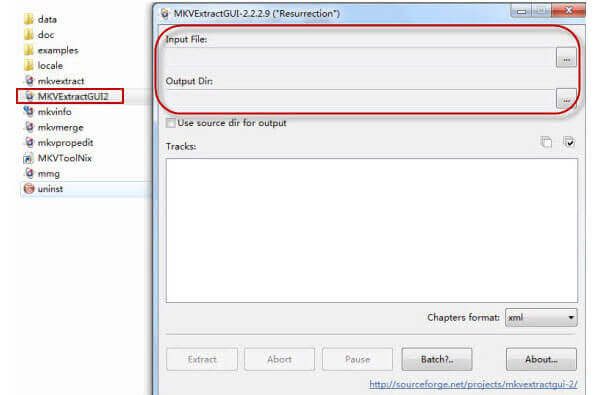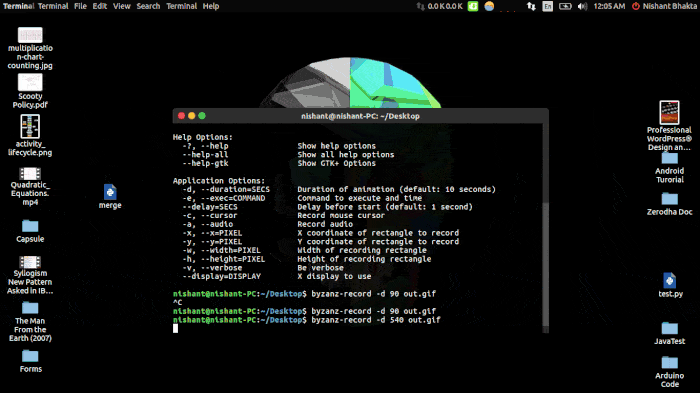Example: Movie.mkv; Movie.srt; Movie.sub; Movie.idx; 3. Open MKVToolNix. Click on the + Add source files button located at the bottom. A “Add media files” window will appear. Within this window, you go to the location on your computer where the MKV video and subtitle file(s) are. Select the MKV video file and subtitle file(s) (.srt. Step 2: Make sure the SRT has the same name as the MKV video file, for example Movie.srt. If they are different, rename it and keep it in the same folder as MKV video file. Step 3: Downlaod MKVToolNix from the Internet and install it on your computer. Add the directory where you installed ffmpeg/mkvmerge to your system's PATH environment variable, ensuring that you can use the ffmpeg/mkvmerge command from any terminal/command prompt. This is the best solution for advanced users. Place the tool in a location already in your system's PATH variable (e.g.
2019-05-28 - By Robert Elder
The purpose of this article is to provide an overview of how to perform various useful tasks with your Raspberry Pi Camera. An emphasis will be made on providing copy and paste examples rather than detailed explanations.
Here is a video guide of the camera installation process:
Here is the simplest possible example of capturing a still image:
Here is an example that shows more commonly used options:
If you run the command 'raspistill' with no parameters:
you'll see a full printout of all available options. Here's what my version shows (it may be different for you):
Here is the simplest possible example of recording a video:
The above command will use 'raspivid' to capture raw .h264 video with no container. Many media players may not play this raw .h264 file correctly, so you can package it into a .mp4 file using this command on the Raspberry Pi:
Here are few examples of other commonly used options for raspivid:
You may need to explicitly include some options like framerate when packaging with MP4Box:
For a full list of all options you can use with 'raspivid' run it without any arugments:
There is a lot of overlap in the arguments used by 'raspivid' and 'raspistill'. Here are some of the ones specific to 'raspivid':
A commonly-requested feature is to be able to stream video data from your Raspberry Pi over the local network and view it on another computer. After having experimented with a number of different techniques for real-time video streaming from the Pi, I've found that the following method yields the lowest latency. Run this command on your laptop/desktop computer:
and run this command on your Raspberry Pi:
Replace the 'REPLACE_WITH_YOUR_IP' part with the LAN IP address of your laptop/desktop computer where you want to view the stream. The above solution uses the 'raspivid' command to read directly from the Raspberry Pi Camera and then forward the data directly over the network using netcat using the 'nc' command. This option works well if you have only one client that needs to view the stream. It's worth noting that the data forwarded over the network by netcat is not encrypted. Also, the port 2222 is just an example. You can use any port you want as long as it's not already in use on your machine and you must make sure both port references match.
This technique can also be extended to one that will work over the internet using port forwarding rules and a proxy server technique just as described in Using SSH to Connect to Your Raspberry Pi Over The Internet.
In order to record from your Raspberry Pi camera, you need to make sure that the '/dev/video0' device is available. Use this command to check:

If you see anything other than 'file not found', then it's available. By default, it's usually not and you need to enable 'bcm2835-v4l2' kernel module to make it appear:
Running the above command will enable the kernel module immediately, but it won't automatically load it on every boot. To do that, you can use this command:
Now you should be able to verify that '/dev/video0' is available. Once you've verified that it is, you can use ffmpeg to record directly from your Raspberry Pi camera:
You may find it necessary in some situations to modify/view/edit parameters through the 'v42l' API before recording video through it. You can use 'v4l2-ctl' to view and modify video recording related options through this driver:

For example, you can use this command:
to see what video recording formats are supported through 'v4l2'. 'v4l2' offers a higher-level more standardized API than the MMAL API (which is used directly by raspivid and raspistill). Here is another command you can use to see what other controls 'v4l2' has:
and here is the output:

Mkvmerge Examples Music
There is an unofficial tool called 'raspiraw' similar to raspistill or raspivid that has been developed by several third-part individuals. This tool allows you to extra raw un-processed bayer data from the image sensor before it has been processed heavily by software. This is useful for people doing novel photography experiments such as pushing the FPS limit as high as it will go with these cameras. Here are several sources that you might find interesting on this topic:
Check out the guide A Guide to Recording 660FPS Video On A $6 Raspberry Pi Camera for even more details on this subject.
You can do time lapse photography by keeping the shutter open for long periods of time. Here is a simple example that I've used that works for taking a picture in a very dark room:
This command will run with a shutter speet of 6 seconds (6000000 microseconds) and run the timelapse for 20 seconds (20000 milliseconds). The 'img_%04d.jpg' part specifies that each file name will be uniquely numbered with '%04' being replaced with a 4 digit number identifying that image in the timelapse sequence. The shutter speed and time lapse time specified don't seem to work very predictably, so you'll have to experiment to find values work for your situation.
Mkvmerge Examples Free
Getting high quality results in very dark environments (such as for astrophotography) is tricky and may require more advanced techniques than simply keeping the shutter open for a long time. You can use this command to 'average' out the images and reduce noise:
The above won't be sufficient for astrophotography since you'll need to modify the tonality curve which the 'convert' command doesn't directly support without doing a lot of math to identify the curve polynomial. See the Imagemagick docs on 'Curves' Adjustments for more info.
One problem you'll encounter with time-lapse photography on the Pi is that light pollution from the Raspberry Pi itself will actually have a significant effect for long exposures taken in very dark rooms. Here are some steps you can take to disable all of the LEDs so they don't affect your image. The steps below were tested on a Raspberry Pi model 3 B.
Disabling Raspberry Pi Camera LED
In order to disable the red LED on the Raspberry Pi camera, edit the file at '/boot/config.txt'.
and make sure the following line is present:

either by modifying it if it's already there but enabled, or by adding it. You'll need to reboot for the change to take effect.
Disabling Raspberry Pi Power Status LED
Use this command to disable the power status LED on your Raspberry Pi:
The change should take effect immediately, but only lasts until a reboot.
Disabling Raspberry Pi Network Status LED

Mkvmerge Examples Download
Use this command to disable the network status LED on your Raspberry Pi:
The change should take effect immediately, but only lasts until a reboot.
| Join My Mailing ListPrivacy Policy | Why Bother Subscribing?
|
